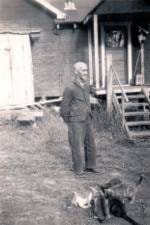Today, businesses across Canada decry the popularity of internet shopping. Many seem to forget that while the World Wide Web may be new, shopping from home is not.
For many people living in rural British Columbia in the early 20th Century, shopping by catalogue was the norm rather than the exception. In the Lakes District, for example, there were few stores, and most of them carried only necessities. Prices in these outlets were often high because everything had to be freighted to the area over rough pack trails and roads that resembled quagmires. During the Klondike Gold Rush, for example, a pound of sugar that cost five cents in Vancouver sold for 65 cents in Teslin.
Completion of the Grand Trunk Pacific Railway in 1914 helped reduce freight charges for communities along the line, but prices were still considerably greater here than in the larger cities like Toronto, Winnipeg, and Vancouver. This made ordering from the catalogue a good financial decision.
Men such as Timothy Eaton built successful businesses in part on the strength of mail-order sales. T. Eaton & Co. issued its first catalogue in 1884, and the publication became an icon of Canadian culture.
In British Columbia, several firms also published catalogues. David Spencer Ltd. of Vancouver (known more commonly as “Spencer’s) shipped a variety of items by mail from its modern department store in downtown Vancouver. In addition to common household goods, its Fall and Winter Catalogue for 1924-25 contained advertisements for rifles, shotguns, and ammunition. A .22 single shot rifle suitable for grouse hunting sold for $5, while a .303 Savage Hammerless Repeater capable of dropping a moose went for $42.50. A box of 100 shells for the grouse gun cost $.50, while 20 cartridges for the moose-stopper went for $2.
These prices may seem incredibly low by today’s standards, but they were still a source of angst for consumers. At the time, the average annual income in Canada was $935 a year. During construction of the railway through this area, the Grand Trunk Pacific enticed men and women north with promises of $4-per-day jobs, yet seldom paid more than $2.50 for a brutal 10-hour shift.
Not even the provincial government’s aggressive program of highway construction reduced the popularity of shopping by mail. As late as 1940, men and women in remote communities throughout B.C. were regularly ordering from stores such as Eaton’s, Simpsons-Sears, and Woodward’s. Some of these stores even offered free shipping as an incentive.
Roswell G. Horr of Marilla was one of those who ordered goods by mail. His request of Aug. 29, 1940, filled by Woodward Stores Ltd. of Vancouver, B.C. and delivered by Beach Trucking of Burns Lake, consisted of the following: 1 carton of groceries (70 lbs), 1 Box of canned goods (64 lbs), 2 boxes of lard (64 lbs), 1 box of biscuits (5 lbs),1 Sack of regular oats (20 lbs), and 1 case of milk (65 lbs).
We don’t know how much Horr paid for the grub, but it probably lasted him several months. Mealtimes must have been a bit monotonous, though.
By the 1960s, Burns Lake had a thriving business community. Everything from shoes to model ships was available at reasonable prices, but many locals still ordered from the catalogue. Even in the early 1970s, children here – indeed, throughout Canada – eagerly awaited arrival of the Eaton’s Christmas Catalogue. They spent days pouring over its pages and marking the items they most wanted to see under the Christmas tree. Many undoubtedly thought Eaton’s and Santa Claus were partners in the grand undertaking.
Why was catalogue shopping all the rage? It remained popular in part because the T. Eaton Company and Simpsons-Sears did more than just provide goods; for people living in remote areas such as Wistaria, they also provided entertainment and a rare glimpse at the outside world. As any old-timer will attest, if you ever ran out of toilet tissue, pages from the Eaton’s catalogue proved a reasonable substitute.
By the 1990s, Canada’s population was becoming concentrated in urban areas, and new “super stores” such as Walmart were entering the marketplace. Despite their record of providing exemplary customer service for decades, Canada’s great retail stores simply could not compete. Sears closed its stores in 1991, and Eaton’s, which in 1930 accounted for almost 60 per cent of all department store sales in Canada, filed for bankruptcy protection in 1997 after 130 years of operation.
History, it is said, repeats itself. Today, mail order shopping is once again in vogue. In 2017, 7.3 per cent of all retail sales in Canada were conducted over the internet. Need proof? Stand outside the local Canada Post outlet for an hour and count the number of Amazon boxes carried out.
Most people will grudgingly admit that internet shopping can be fun, but can it really complete with ordering from the Eaton’s catalogue? Those of us born before 1960 would likely say it is a poor substitute.
© Michael Riis-Christianson and the Lakes District Museum Society
